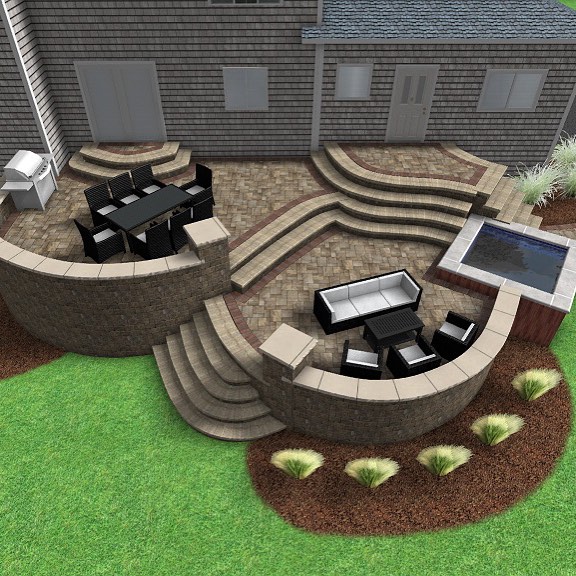Introduction: A backyard landscaping project can transform your outdoor space into a beautiful oasis, enhancing the value of your home and providing a place for relaxation and entertaining. However, before embarking on such a project, it is essential to have a budget in mind to ensure that your goals align with your financial resources. In this comprehensive guide, we will walk you through the process of determining a realistic budget for your backyard landscaping project. We will cover important considerations such as evaluating the scope of the project, determining priorities, considering material costs, factoring in labor expenses, and accounting for ongoing maintenance. By the end of this guide, you will have the knowledge and tools to make informed decisions about your landscaping budget and successfully manage your project within your means.
1. Evaluate the Scope of the Project: The first step in deciding on a budget for your backyard landscaping project is to evaluate the scope of the project. Consider the size of your backyard, the current condition of the space, and the desired outcome. Are you looking to create a simple, low-maintenance landscape or a more elaborate design with multiple features and amenities? Understanding the scope will help you estimate the overall cost and determine a realistic budget.
2. Determine Priorities: Once you have evaluated the project’s scope, it is crucial to determine your priorities. Identify the elements or features that are most important to you. This could include a patio, outdoor kitchen, fire pit, water feature, or specific plants and flowers. By determining your priorities, you can allocate your budget accordingly and focus your resources on the elements that matter most to you.
3. Consider Material Costs: Materials play a significant role in the overall cost of a backyard landscaping project. Research the costs of various materials such as pavers, stones, plants, and outdoor structures. Consider factors like durability, maintenance requirements, and aesthetics when selecting materials. It’s also important to factor in additional expenses like soil, fertilizers, mulch, and irrigation systems.
By understanding material costs, you can make informed decisions and ensure that your budget aligns with your desired materials. 4. Factor in Labor Expenses: Labor expenses are another critical component of your landscaping budget. Hiring professional landscapers or contractors can ensure a high-quality result, but it comes at a cost. Research local rates for landscaping services and obtain multiple quotes to compare prices.
Consider the complexity of the project, the time required, and the expertise needed when budgeting for labor expenses. Keep in mind that more intricate designs or custom features may require specialized contractors, which might result in additional costs. 5. Account for Ongoing Maintenance: Many homeowners often forget to consider ongoing maintenance costs when setting their landscaping budget. Landscaping projects require regular upkeep to ensure they remain beautiful and functional.
Budget for expenses such as lawn mowing, plant fertilization, trimming, and regular inspections. Additionally, consider the long-term maintenance needs of features like water features, irrigation systems, and outdoor structures. By accounting for ongoing maintenance, you can avoid unexpected expenses in the future. 6. Set Realistic Budget Goals: Setting realistic budget goals is essential to avoid overspending or compromising on quality.
It’s crucial to align your budget with your goals and financial resources. Consider what you can comfortably afford and the value you will receive from your investment. Keep in mind that backyard landscaping projects can vary significantly in cost, depending on the scope and desired features. A modest budget can still yield satisfying results if properly planned and prioritized. 7.
Research Prices, Obtain Multiple Quotes, and Negotiate: To ensure your budget is well-informed and competitive, research prices extensively. Obtain multiple quotes from different contractors and suppliers to compare costs and services. It’s essential to ask for detailed breakdowns of materials, labor, and any additional fees. This will allow you to identify any potential hidden or unnecessary costs. Use these quotes as negotiation tools and don’t be afraid to negotiate with contractors to secure the best price while maintaining quality.
8. Prioritize Features and Allocate Funds Accordingly: With a set budget in mind, it’s time to prioritize the various features and allocate funds accordingly. Identify the must-have elements or features and allocate a significant portion of your budget to them. For example, if an outdoor kitchen is a top priority, allocate a substantial portion of your budget to that area. Consider functionality, aesthetics, and long-term value when prioritizing features.
By allocating funds strategically, you can achieve a well-balanced and satisfying end result. 9. Example Budget Scenarios and Investment Impact: To provide a clearer understanding of the impact of different investment levels, let’s look at a few example budget scenarios. These examples will demonstrate how budget allocation can affect the overall outcome of a landscaping project: – Scenario 1: Modest Budget ($5,000 – $10,000) With a modest budget, focus on essential elements like improving soil quality, adding easy-to-maintain plants, and creating a simple patio or deck area. Consider DIY options to save on labor costs.
Allocate a smaller portion of the budget to decorative elements like lighting or small water features. – Scenario 2: Moderate Budget ($10,000 – $20,000) With a moderate budget, you can invest in higher-quality materials, hire professional landscapers for specific tasks, and include additional features like a fire pit or seating area. Allocate a significant portion of the budget to plants and landscaping elements that match the overall vision for your outdoor space. – Scenario 3: High-End Budget ($20,000 – $50,000+) With a high-end budget, you have more flexibility to include elaborate features like an outdoor kitchen, swimming pool, or custom-built structures. Allocate a larger portion of the budget to professional contractors, premium materials, and specialized design elements.
Consider long-term value and durability when making investment decisions. 10. Data, Research, and Industry Standards: To support your decisions and ensure you are working with reasonable expectations, it’s essential to consider industry standards and research on average landscaping costs and return on investment. Various studies and reports provide average costs and potential return on investment for different landscaping elements. This data can help guide your decision-making process and ensure that your budget is in line with industry standards.
11. Step-by-Step Process for Deciding on a Landscaping Budget: To summarize the process of deciding on a budget for your backyard landscaping project, follow these steps: – Evaluate the scope of the project. – Determine your priorities. – Research material costs and consider ongoing maintenance. – Factor in labor expenses and obtain multiple quotes.
– Set realistic budget goals that align with your financial resources. – Research prices, negotiate, and compare quotes. – Prioritize features and allocate funds accordingly. – Consider example budget scenarios and investment impact. – Utilize data, research, and industry standards.
– Create a step-by-step action plan for your project. Conclusion: Deciding on a budget for your backyard landscaping project is a crucial step in ensuring a successful outcome that aligns with your goals and financial resources. By evaluating the scope of the project, determining priorities, considering material costs and labor expenses, and accounting for ongoing maintenance, you can make informed decisions and create a realistic budget. Use research, data, and industry standards to support your decisions, and utilize the tips provided in this guide to research prices, obtain multiple quotes, negotiate, and prioritize features. With careful planning and budgeting, you can transform your backyard into a beautiful oasis that brings joy and value to your home for years to come.
Conclusion: Deciding on a budget for your backyard landscaping project is a crucial step in ensuring a successful outcome that aligns with your goals and financial resources. By evaluating the scope of the project, determining priorities, considering material costs and labor expenses, and accounting for ongoing maintenance, you can make informed decisions and create a realistic budget. Use research, data, and industry standards to support your decisions, and utilize the tips provided in this guide to research prices, obtain multiple quotes, negotiate, and prioritize features. With careful planning and budgeting, you can transform your backyard into a beautiful oasis that brings joy and value to your home for years to come.


Recent Comments